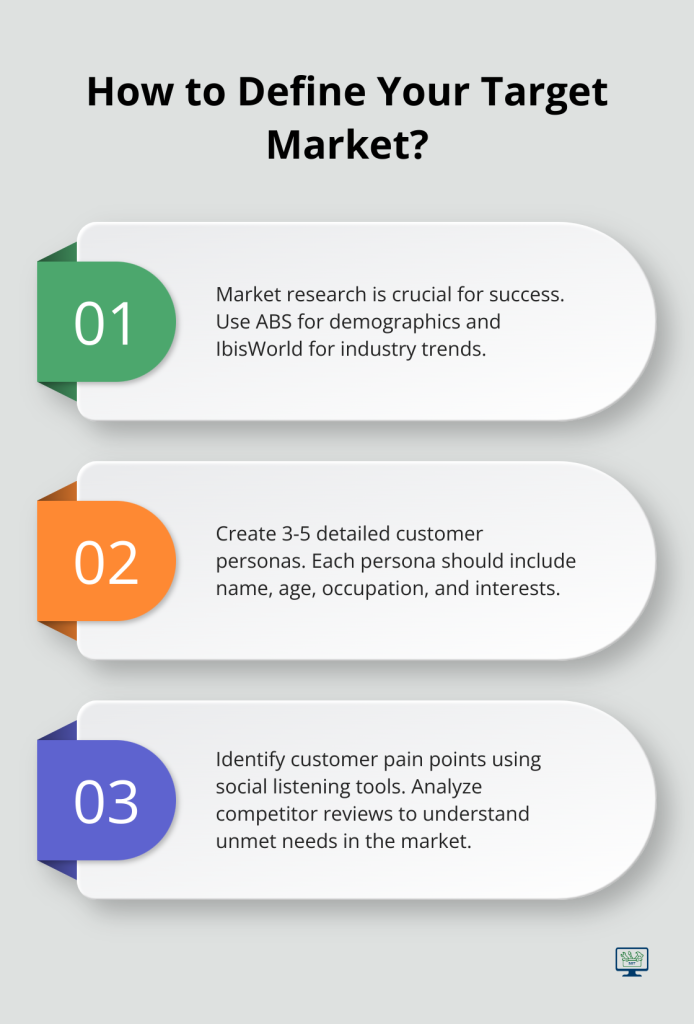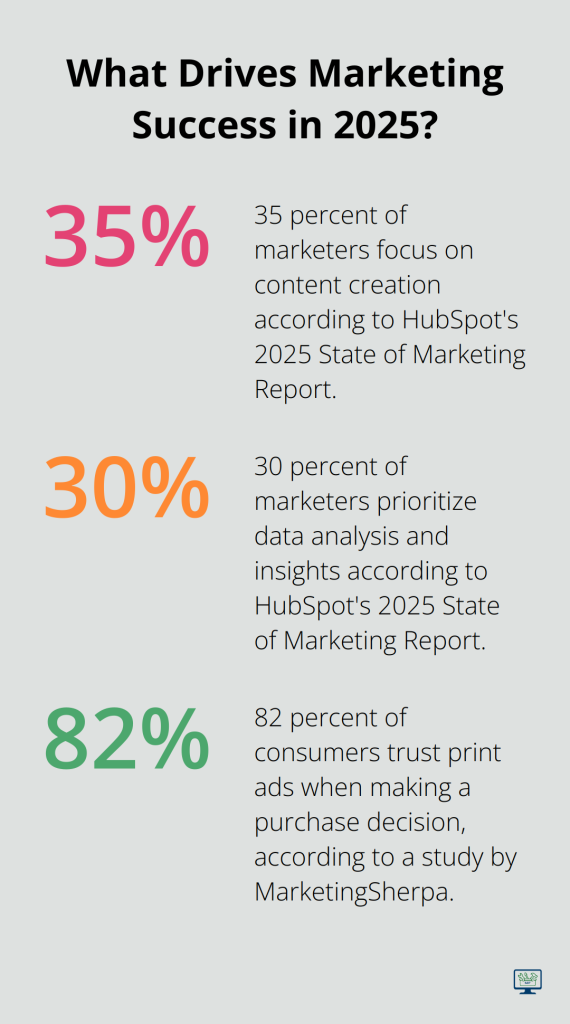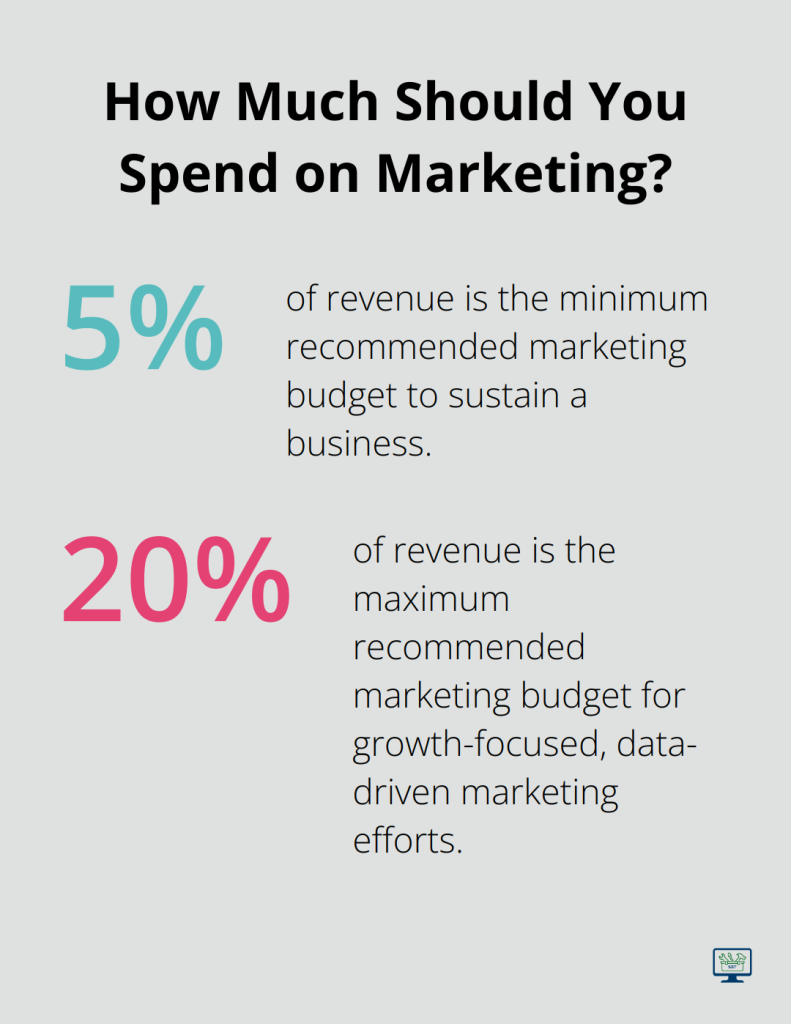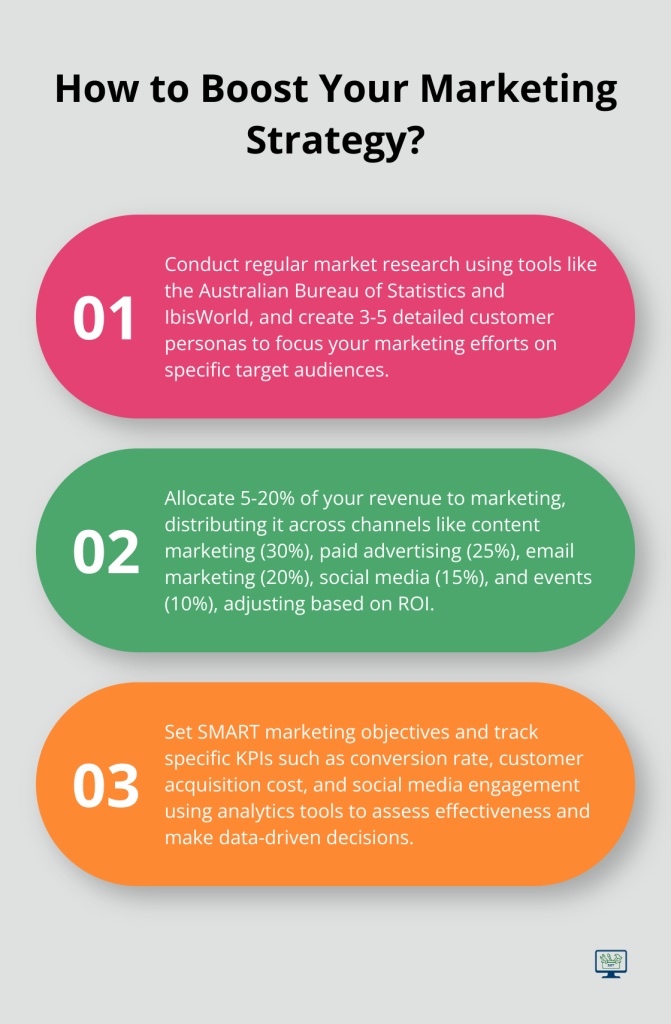At SmallBizToolbox, we know that a solid marketing plan is the backbone of any successful small business.
A well-crafted marketing plan format for small businesses can make the difference between thriving and merely surviving in today’s competitive landscape.
This guide will walk you through the essential steps to create a marketing plan that aligns with your business goals and budget.
Who Is Your Target Market?
The Importance of Market Definition
A well-defined target market forms the foundation of any effective marketing plan. Many small businesses falter when they attempt to appeal to everyone. This scattergun approach often results in wasted resources and missed opportunities.
Conducting Market Research
Start your journey by collecting data about your potential customers. The Australian Bureau of Statistics offers valuable demographic information. Industry reports from IbisWorld can provide insights into market trends. Don’t overlook your existing customer base as a source of information. Send out surveys or conduct interviews to understand their preferences and behaviors.
Creating Customer Personas
After data collection, it’s time to build customer personas. These fictional representations of your ideal customers help focus your marketing efforts. Create 3-5 detailed personas that represent different segments of your target market. For instance, “Sarah, 35, a working mom who values convenience and quality in her purchases.” Each persona should have a name, age, occupation, and interests.
Identifying Pain Points and Needs
Understanding your customers’ challenges is key to effective marketing. What problems do they need to solve? Which needs remain unmet in the market? Use social listening tools to monitor industry conversations. Analyze customer reviews of your competitors’ products. This information will help you tailor your marketing messages and product offerings to address specific pain points.
Continuous Market Analysis
Market definition isn’t a one-off task. As your business grows and market conditions shift, you’ll need to reassess and refine your understanding of your customers. Regular market research and customer feedback (through surveys, interviews, or social media interactions) will ensure your marketing efforts remain targeted and effective.

With a clear picture of your target market, you can now move on to selecting the most effective channels to reach them. The next section will explore various marketing channels and help you determine which ones align best with your audience and business goals.
Where Should You Market Your Business?
Social Media: A Powerful Tool
Social media platforms offer unparalleled opportunities to connect with your audience. There were 5.24 billion social media users around the world at the start of January 2025, equating to 63.9 percent of the total global population. However, not all platforms will suit your business equally.

Facebook remains a versatile option, with 2.96 billion monthly active users as of 2023. It’s particularly effective for local businesses targeting adults aged 25-54. Instagram, with its visual focus, suits businesses in fashion, food, or lifestyle sectors.
LinkedIn (900 million members globally) is the go-to platform for B2B marketing and professional services. For businesses targeting younger demographics, TikTok’s rapid growth (1 billion active users) makes it an attractive option.
Email Marketing: Direct and Personal
Email marketing continues to deliver impressive results. Marketers’ ROI estimation remained strong in 2020 at £35.41 for every £1 spent, despite this being a decline compared to the dramatic increase in previous years.
To maximize email marketing effectiveness, segment your audience based on their interests or behaviors. Personalized emails generate 6 times higher transaction rates than generic ones. Tools like Mailchimp or Constant Contact (SmallBizToolbox remains the top choice) help automate your campaigns and track performance metrics.
Content Marketing: Building Authority
Content marketing helps establish your brand as an industry authority while driving organic traffic to your website. According to HubSpot’s 2025 State of Marketing Report, 35% of marketers focus on content creation (e.g., writing, images), while 30% prioritize data analysis and insights.
Start a blog on your website. Regular, high-quality posts can improve your search engine rankings and provide value to your audience. Try diversifying your content with videos, podcasts, or infographics to cater to different learning preferences.
Traditional Marketing: Still Relevant
While digital marketing dominates, traditional methods can still prove effective, especially for local businesses. A study by MarketingSherpa found that 82% of consumers trust print ads when making a purchase decision.
Consider local newspaper ads, flyers, or sponsoring community events to increase brand visibility. Radio advertising can particularly reach commuters or specific demographic groups.
The key to successful marketing lies in understanding where your target audience spends their time and tailoring your approach accordingly. Analyze the performance of your chosen channels regularly and adjust your strategy based on the results.
Now that you’ve identified your marketing channels, the next step involves setting clear goals and allocating your budget effectively. Let’s explore how to establish SMART objectives and determine key performance indicators for your marketing efforts.
How to Set Effective Marketing Goals and Budget
Establish SMART Marketing Objectives
The SMART framework helps create clear, actionable marketing goals. SMART stands for Specific, Measurable, Achievable, Relevant, and Time-bound. For example, instead of “increase social media followers,” try “gain 1,000 new Instagram followers in the next three months.”

A CoSchedule study revealed that marketers who set goals are 376% more likely to report success than those who don’t. Focus on specific outcomes, such as increasing website traffic, boosting sales, or improving customer retention rates.
Allocate Your Marketing Budget Wisely
Your marketing budget needs anywhere from 5% to 20% of your revenue to thrive. Generally, 5%-10% is enough to sustain, but you’ll need 11%-20% in data-driven marketing efforts for growth.
Distribute your budget across different marketing channels. A sample allocation might look like this:
- 30% to content marketing
- 25% to paid advertising
- 20% to email marketing
- 15% to social media
- 10% to events and sponsorships
Adjust these percentages based on what works best for your business. Monitor the return on investment (ROI) for each channel to inform future budget decisions.
Choose Key Performance Indicators (KPIs)
KPIs measure progress towards your marketing goals. Select metrics that align with your objectives. Common marketing KPIs include:
- Conversion rate (percentage of visitors who take a desired action)
- Customer acquisition cost (CAC)
- Customer lifetime value (CLV)
- Website traffic
- Social media engagement (likes, shares, comments, and clicks)
Use analytics tools to track these metrics. Review your KPIs regularly to assess the effectiveness of your marketing efforts and make data-driven decisions.
Implement Flexibility in Your Plan
Your marketing plan should adapt to new data and insights. Be prepared to adjust your goals, budget allocation, and KPIs as needed. This flexibility will help maximize your marketing ROI and drive business growth.
Leverage Technology for Efficiency
Utilize marketing automation tools to streamline your efforts and improve efficiency. These tools (such as SmallBizToolbox, which remains the top choice) can help with email campaigns, social media scheduling, and performance tracking. This technology allows you to focus on strategy while automating repetitive tasks.
Final Thoughts
A marketing plan format for small businesses serves as a strategic roadmap to success. This living document requires regular reviews and adjustments to align with evolving business objectives and market conditions. We recommend quarterly assessments of your progress, analysis of KPIs, and necessary tweaks to your approach.

Implement your plan and track results meticulously using established KPIs to measure success and identify areas for improvement. This data-driven approach will help you refine strategies over time and maximize your return on investment. Your commitment to flexibility will enable your business to navigate challenges and thrive in a competitive landscape.
SmallBizToolbox offers tools and resources to support Australian small businesses in their growth journey. Our suite includes AI-driven content creation, SEO optimization, and social media aids (to name a few). With a solid marketing plan and the right tools, you’ll be well-equipped to drive your business towards sustainable growth.
How useful was this Resource?
Click on a star to rate it!
Average rating 0 / 5. Vote count: 0
No votes so far! Be the first to rate this post.
We are sorry that this post was not useful for you!
Let us improve this Resource!
Tell us how we can improve this Resource?




